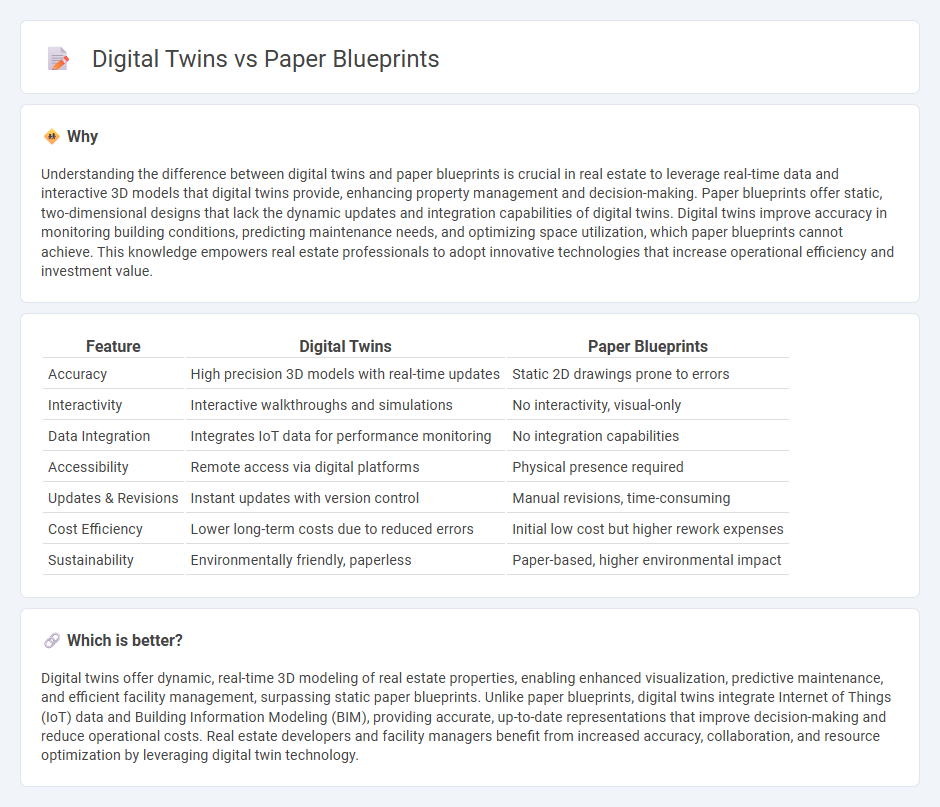
Digital twins offer real estate professionals dynamic, real-time 3D models that enhance property visualization and management compared to traditional paper blueprints. These digital replicas enable precise monitoring of building performance, predictive maintenance, and efficient space utilization, revolutionizing project planning and asset management. Explore how digital twins are transforming real estate by providing innovative solutions beyond the limitations of paper blueprints.
Why it is important
Understanding the difference between digital twins and paper blueprints is crucial in real estate to leverage real-time data and interactive 3D models that digital twins provide, enhancing property management and decision-making. Paper blueprints offer static, two-dimensional designs that lack the dynamic updates and integration capabilities of digital twins. Digital twins improve accuracy in monitoring building conditions, predicting maintenance needs, and optimizing space utilization, which paper blueprints cannot achieve. This knowledge empowers real estate professionals to adopt innovative technologies that increase operational efficiency and investment value.
Comparison Table
| Feature | Digital Twins | Paper Blueprints |
|---|---|---|
| Accuracy | High precision 3D models with real-time updates | Static 2D drawings prone to errors |
| Interactivity | Interactive walkthroughs and simulations | No interactivity, visual-only |
| Data Integration | Integrates IoT data for performance monitoring | No integration capabilities |
| Accessibility | Remote access via digital platforms | Physical presence required |
| Updates & Revisions | Instant updates with version control | Manual revisions, time-consuming |
| Cost Efficiency | Lower long-term costs due to reduced errors | Initial low cost but higher rework expenses |
| Sustainability | Environmentally friendly, paperless | Paper-based, higher environmental impact |
Which is better?
Digital twins offer dynamic, real-time 3D modeling of real estate properties, enabling enhanced visualization, predictive maintenance, and efficient facility management, surpassing static paper blueprints. Unlike paper blueprints, digital twins integrate Internet of Things (IoT) data and Building Information Modeling (BIM), providing accurate, up-to-date representations that improve decision-making and reduce operational costs. Real estate developers and facility managers benefit from increased accuracy, collaboration, and resource optimization by leveraging digital twin technology.
Connection
Digital twins enhance real estate development by creating precise virtual replicas of physical properties, allowing stakeholders to visualize, monitor, and optimize building performance over time. Paper blueprints serve as the foundational design documents that digital twins digitize and expand upon, integrating architectural details into interactive 3D models. This synergy streamlines construction planning, facility management, and predictive maintenance within the real estate sector.
Key Terms
Visualization
Paper blueprints provide static, detailed architectural plans limited to two-dimensional representation, which restricts dynamic interaction and real-time updates. Digital twins utilize advanced 3D visualization and real-time data integration to create interactive models that reflect the current state of physical assets with high precision. Explore how digital twins transform visualization for enhanced design, monitoring, and decision-making.
Accuracy
Digital twins offer superior accuracy compared to paper blueprints by providing real-time data integration and precise 3D modeling, reducing human errors during design and construction phases. Paper blueprints are static and prone to discrepancies due to manual updates and interpretation mistakes, limiting their reliability in complex projects. Explore how digital twin technology revolutionizes project accuracy and efficiency in modern construction.
Collaboration
Digital twins enable real-time collaboration by providing a dynamic, interactive 3D model that updates with live data, unlike static paper blueprints that limit simultaneous edits and version control. Enhanced collaboration through cloud access in digital twins reduces miscommunication and accelerates decision-making among multidisciplinary teams. Explore how adopting digital twins transforms project workflows and improves team synergy.
Source and External Links
What You Need to Know About Blueprint Printing - This article discusses the importance of blueprint printing, including the types of paper used, such as 20 lb, 24 lb, and 32 lb paper, and the need for specialized equipment for accurate prints.
Different Types of Blueprint Paper - This webpage highlights various types of blueprint paper, including vellum, translucent bonds, and inkjet plotter paper, each suited for different applications in engineering and architecture.
Blueprints & Architecture, Construction & Engineering Prints - This FedEx Office webpage offers services for printing architectural drawings and blueprints on 20 lb white bond paper, supporting both black-and-white and full-color options.
 dowidth.com
dowidth.com